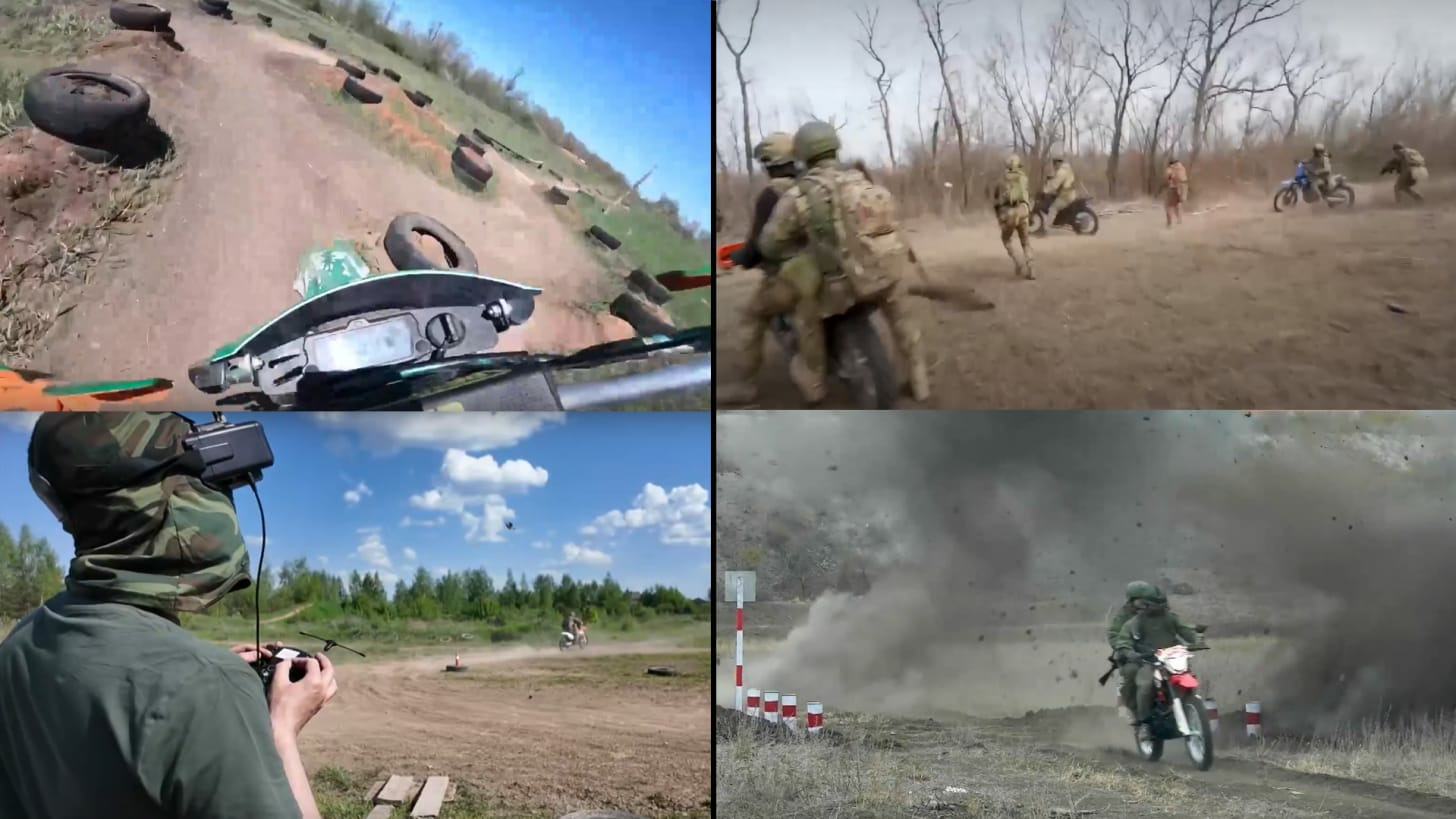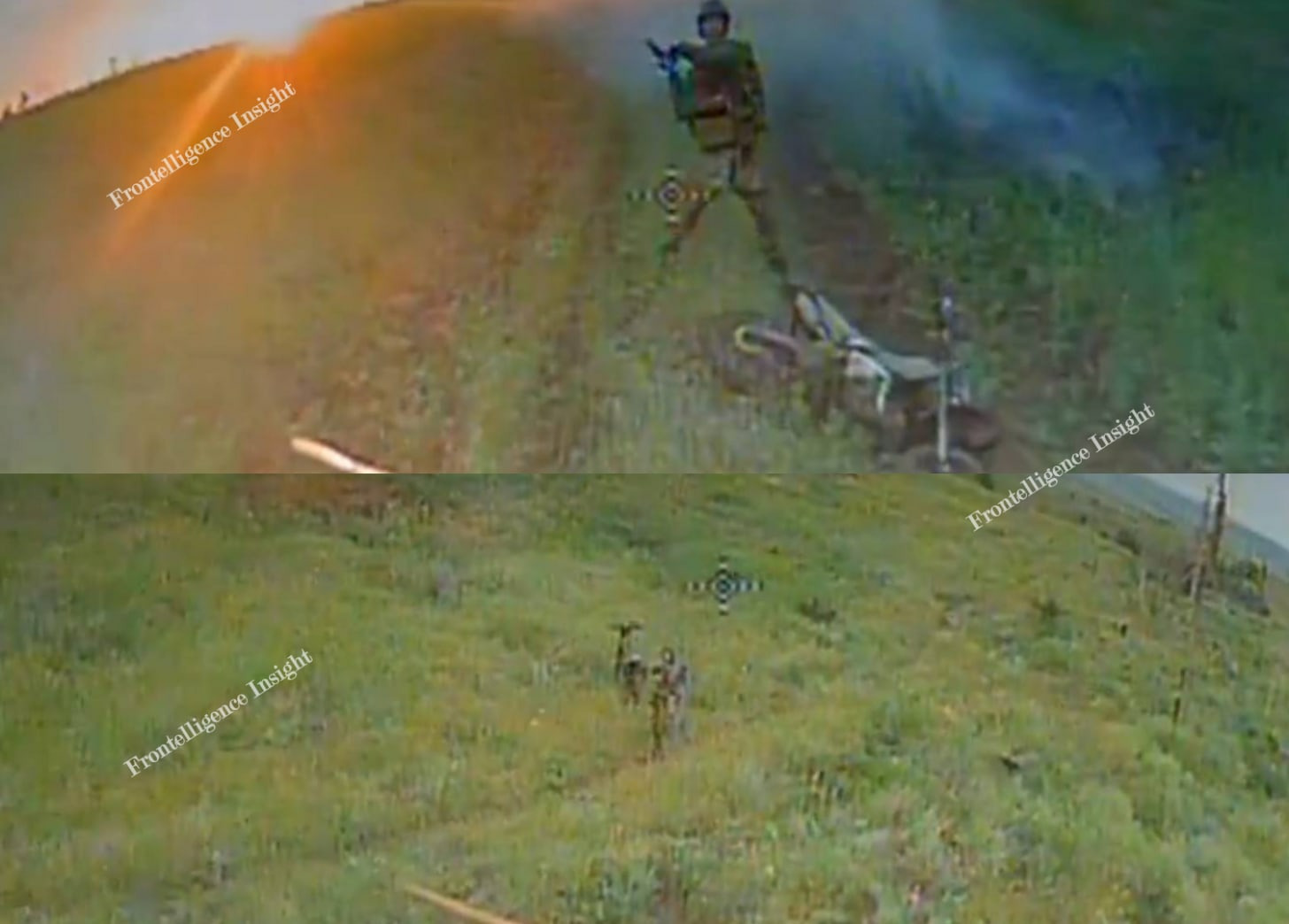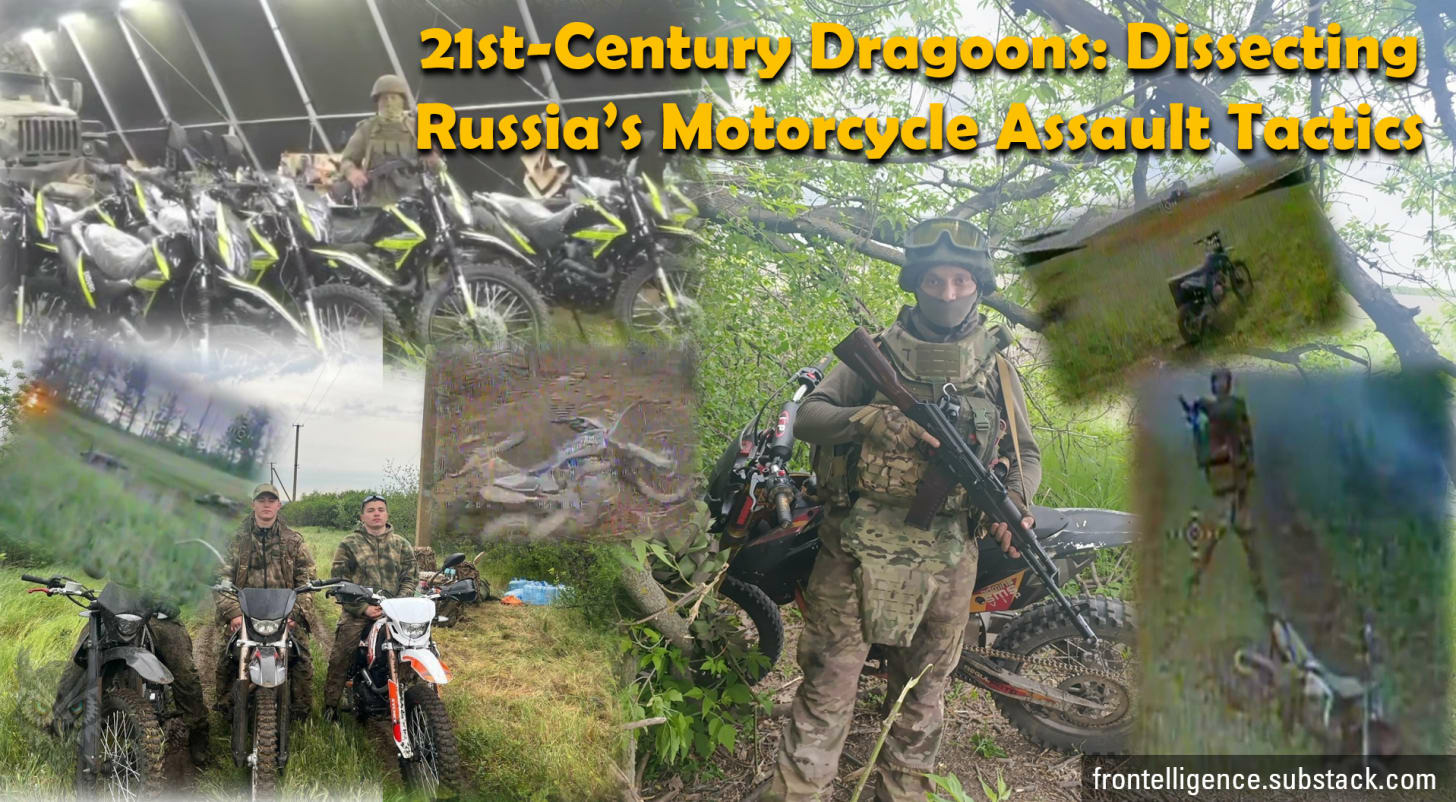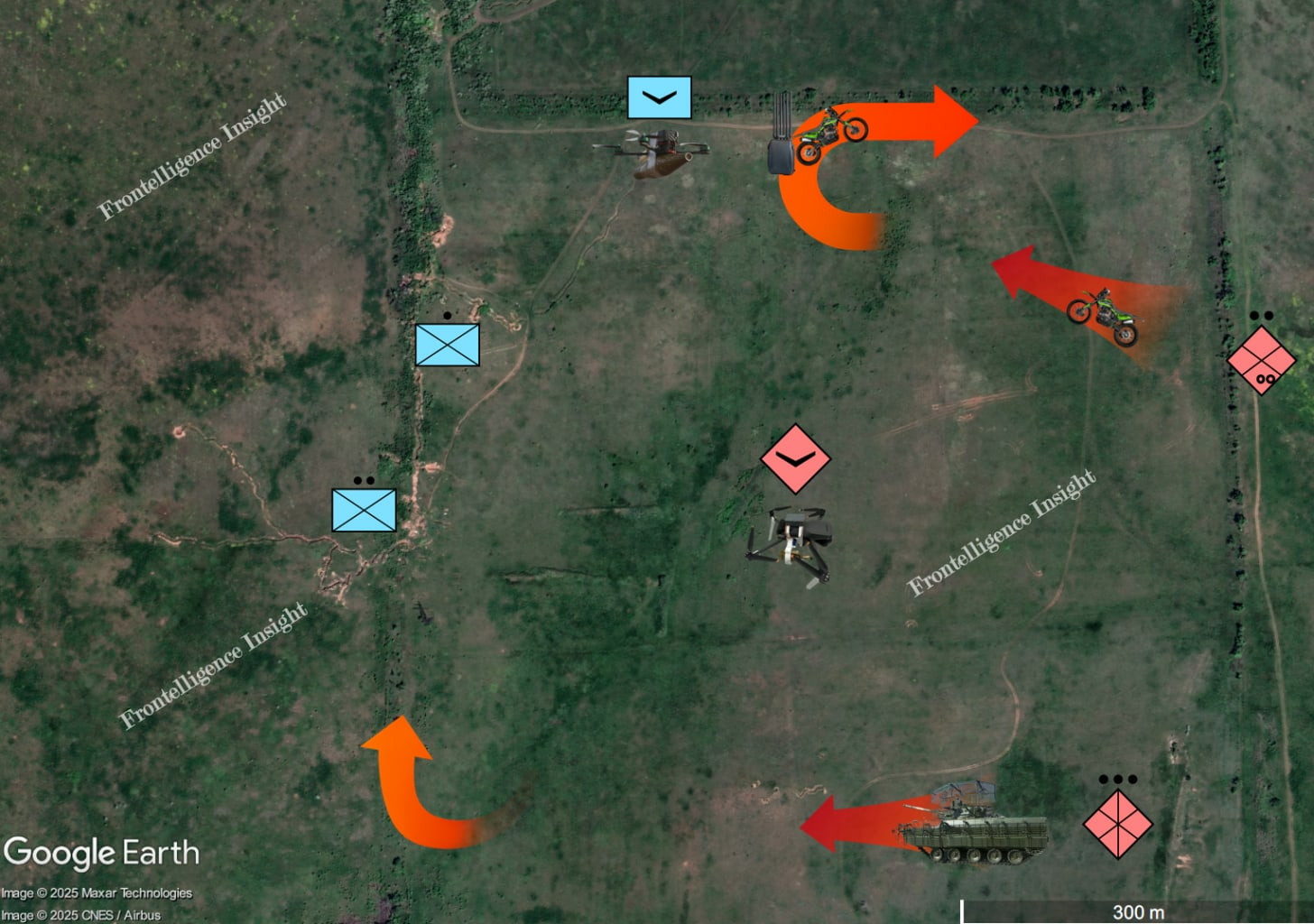The reduced time between detection and engagement, driven by real-time drone surveillance and the high velocity of FPV attack drones, has created a hostile environment for traditional armored platforms on the battlefield. As a result, both sides in the war have been forced to adapt.
One such adaptation emerged in 2024, when Russian motorcycle assault groups began appearing with increasing frequency along the frontlines. Their presence quickly caught public attention, and their use has since become a common feature of frontline engagements. More recently, Ukrainian forces have also announced the formation of their own motorcycle units.
Considering the growing speculation about the effectiveness of motorcycle assault groups, particularly in a battlefield that remains relatively static but is saturated with artillery and drone activity, our team undertook a focused investigation to better understand this evolving tactic.
This report offers a detailed, though generalized, assessment of motorcycle assault group composition, tactics, and equipment as of June 2025. It draws primarily on intercepted Russian tactical-level documentation, testimony from frontline infantry and drone operators, publicly available interviews of Russian motorcycle crews and publicly available reports issued by the Ukrainian military. That said, it is important to note that the details of training, organization, and combat performance of these units can vary significantly between formations - and we do not have unified data across the entire frontline to offer a definitive, entirely data-backed conclusion.
Table of Contents:
Intro
I. Conditions for Adoption
II. Force Structure, Missions, and Tactics
III. Training and Field Drills
IV. Motorcycle Inventory
V. Combat Feedback: Ukrainian Perspective
VI. Summary and Outlook
I. Conditions for Adoption
One of the key conclusions of our research is that before extrapolating the experience of Russian motorcycle assault groups to other theaters or advocating for their adoption by Ukrainian forces, we should first understand the underlying challenges and battlefield conditions that drove Russia to pursue this adaptation in the first place.
In a battlefield where neither side holds air supremacy and large-scale combined-arms operations remain difficult to execute, combat has shifted to smaller tactical formations - usually at the squad or company level, backed by armored vehicles. In this environment, traditional platforms like tanks and IFVs face growing challenges, especially amid constant artillery fire and the widespread use of cheap, fast drones.
In response to these challenges and the accelerating depletion of armored vehicle reserves, Russian forces have increasingly relied on small tactical units using concealed movement to reduce the risk of detection. However, this comes at the cost of mobility and operational flexibility. Once discovered, such groups are often quickly eliminated by drone or artillery strikes. Even when they achieve tactical success, their ability to exploit defense breakthroughs are seriously limited when operating on foot.
So what are the factors that have created fertile ground for the growing use of motorcycles on the battlefield - and what can they tell us about the conditions that make their use viable?
The first is the Russian military’s persistent inability to conduct large-scale, coordinated combined-arms operations capable of breaching Ukrainian defenses. Even when Russia manages to amass significant formations, including hundreds of tanks, armored personnel carriers, artillery systems, missile units, and air defense assets, it continues to struggle with the integration and synchronization required for effective combined-arms assaults. As a result, Russians have shifted toward deploying small, low-quality assault groups in frequent, attritional attacks. This approach is focused on gradually wearing down Ukrainian forces and identifying weak points that can later be exploited
The second factor is the lethality of well-prepared defensive positions, particularly those enabled by real-time reconnaissance and precision-guided munitions. On today's battlefield, advanced surveillance tools allow defenders to identify high-value targets quickly, while massed precision fires make it possible to neutralize them.
Limited manpower and thinly held frontlines in Ukraine make it feasible for small, mobile units to slip through defenses. Unlike conventional infantry groups, successful motorcycle infiltrations can penetrate deeper into rear areas while remaining harder to target with artillery and more capable of suppressing FPV drones using larger electronic warfare (EW) systems mounted on motorcycles.
High loss tolerance in assault operations. As will be discussed further in this report, motorcycle assault tactics depend on mass deployment. The concept accepts heavy losses among assaulting units, as long as a small fraction succeeds in breaching enemy lines and completing the objective.
Lack of better-armored troop transport options. While Soviet-era BMPs and BTRs are vulnerable to FPV drones, more modern Western vehicles like the Bradley IFV’s offer better protection and have demonstrated greater survivability for transported personnel during artillery or drone strikes. Russia’s current armored fleet lacks a viable mass-produced alternative to provide a better protection
Geography and seasonal conditions favor mobility. Dry, flat steppe terrain significantly enhances the effectiveness of motorcycle assaults. In contrast, heavy snow, mountainous areas, or dense forests and jungles are much less suitable for this kind of maneuvering.
Once the advantages of motorcycle assault groups became clear, we assessed whether their benefits could justify the risks. At roughly $2,000–$4,000 apiece (depending on model and condition), these bikes are far cheaper to replace than infantry fighting vehicles, with minimal maintenance costs. Their mobility and low silhouette allow them to slip past obstacles and evade detection more easily than larger platforms - especially when paired with on-board electronic-warfare gear. Concealable even in small buildings, and nearly silent at night in electric variants, they preserve the element of surprise. A motorcycle can reach a position in minutes, outpacing a noisy, slower BMP or tank and narrowing the window for enemy FPV-drone response. Finally, they let teams carry heavier weapons - ATGMs, grenade launchers, or other support arms - along flanks, delivering fast, flexible fire support where it’s needed most.
II. Force Structure, Missions, and Tactics
Despite the term “assault” in their name, these units are not solely used for direct assault attacks. In practice, their roles are more diverse - ranging from diversionary maneuvers and reconnaissance to behind-the-line infiltration, logistics and flanking support during larger assaults.
More importantly, the motorcycle serves primarily as a means of rapid transport, delivering troops to their objectives rather than serving as a combat platform itself. As leading military analyst Michael Kofman and B.A. Friedman have noted, a more accurate historical analogy might be “dragoons”— mounted infantry who rode into battle but dismounted to fight on foot. Dragoons were used for skirmishing, reconnaissance, flanking, and screening operations - tactical roles that closely resemble how Russian motorcycle units are now being employed.
The structure of a motorcycle assault group can vary depending on the unit, its assigned tasks, and available resources to the parent unit. However, in general, such a group typically consists of 6 to 8 motorcycles, with 1 to 2 riders per vehicle, resulting in a total personnel count ranging from 6 to 16 individuals on average.
At least one motorcycle in the group is usually equipped with a drone detection system, which scans the area for the presence of FPV drones. Additionally, these groups are expected to carry 2 to 3 electronic warfare (EW) stations, either mounted directly on motorcycles or carried in backpack on a rider, to disrupt communications between drones and drone operators during assault.

Motorcycles with two riders optionally have the passenger as the primary combatant, ready to engage both ground targets and aerial threats, such as drones while on the move. In some cases, motorcycles are equipped with gun mounts for the driver, enabling limited fire capability. However, the driver mounted gun appears to be quite uncommon in practice.

Common Tactical Maneuvers for Motorcycle Assault Groups:
Single Flanking: A maneuver where motorcycles circle the enemy position from one side to attack from an unexpected direction.
Pincer Movement: Simultaneous flanking from both sides to overwhelm or encircle the enemy.
Deep Penetration: Rapid advance beyond the first line of defense to disrupt rear-area logistics, rotations etc.
Diversionary Maneuver: Aimed at drawing enemy attention and fire away from the main assault force.
Reconnaissance-in-Force: Probing enemy positions while remaining mobile, often testing defensive response and locating weaknesses.
Beyond direct combat, motorcycle assault units fulfill other support roles. They conduct limited medical evacuation - extracting wounded personnel one at a time due to space and weight constraints, and carry critical supplies such as food, water, or ammunition within their load limits. In offensive operations, these teams have even moved troops into urban objectives: during the capture of Kurakhove, columns of three to four motorcycles, shuttled small groups of soldiers rapidly into the city. Finally, they rotate individual fighters in and out of frontline positions, again limited by the bike’s capacity but offering a faster alternative to foot or vehicle movement.
III. Training and Field Drills
While there were no systematic efforts to implement a unified training program across Russia’s ground forces in early 2024, a number of localized, unit-driven initiatives emerged from the bottom up. These early efforts lacked coordination and consistency. By the summer of 2024, however, the Russian Ministry of Defense began taking steps to formalize motorcycle and all-terrain vehicle (ATV) training programs across military training centers inside Russia.
In July 2024, during a visit to a training facility in the Leningrad Military District, Defense Minister Andrey Belousov emphasized the need for dedicated courses on ATVs, buggies, and motorcycles. He cited their growing role in the rapid delivery of ammunition, food, and the evacuation of the wounded from frontline positions.
As of spring 2025, motorcycle and ATV training is underway both within Russia and across the occupied territories of Ukraine, integrated into force groupings at the operational level.
The training typically takes place on improvised or semi-permanent motocross-style tracks, designed for motorcycles and other light off-road vehicles. While the quality of these facilities varies, they tend to share key features: obstacle courses simulating minefields, uneven terrain, sharp ascents and descents. Training exercises often culminate with soldiers dismounting to engage targets from firing positions or to storm simulated trenches and dugouts.

More advanced training centers include drone-supported observation, where instructors imitate FPV attacks and monitor assault groups from above to provide feedback. However, there is limited information on how rigorous these after-action reviews are, or how much time is devoted to correcting mistakes.
The duration of training varies widely. Basic riding instruction typically spans at least 16 hours, while more advanced tactical courses — including combat maneuvers and vehicle-based assault techniques — can take up to two months. In combat conditions, however, where personnel turnover is high, the full course is rarely feasible. As a result, most trainees likely undergo compressed programs reportedly lasting between two and four weeks.
This Substack is reader-supported. To receive new posts and support my work, consider becoming a free or paid subscriber.
IV. Motorcycle Inventory
Given the scale of the war and the demands on Russia’s military, a question naturally emerges: where are the motorcycles coming from, what models are used, and can Russia meet its needs with domestic production?
The short answer to the last question is no. Most motorcycles deployed at the front are foreign-made, primarily sourced from China. This comes down to two basic factors: cost and production scale. While Russia’s defense sector had been developing motorcycles even before the war, and even ramped up efforts once demand surged, it still falls short of meeting frontline needs.
Equally important, it appears the Russian state is not the only supplier yet. As with drones, motorcycles often reach units through volunteers, local authorities from the unit’s home region, personal purchases by servicemembers, and state procurement.
Given the decentralized sourcing of motorcycles, the fleet in Russian units is notably diverse. Still, as previously noted, Chinese-made off-road models, particularly enduro-style bikes, dominate. As of June 2025, one of the most common models observed by our team was produced by Sharmax Motors, a Dubai-based company with manufacturing facilities in China. Among the most frequently used is the Sharmax Sport 280 from the Enduro line, with prices ranging from 180,000 to 300,000 rubles (approximately $1900 to $3,200).
Another emerging alternative, though still less common, is the use of electric motorcycles. These are gaining traction due to several advantages over gasoline-powered models: they’re significantly quieter and harder to detect with thermal imaging.
V. Combat Feedback: Ukrainian Perspective
Battlefield theories and expectations from tactical experimentation often diverge from reality. Many Ukrainian interviewees expressed skepticism about the growing "hype" surrounding motorcycles as a battlefield wunderwaffe, emphasizing that while motorcycles can be useful under specific conditions, they remain just a platform - far from a transformative innovation.
As an assault platform, motorcycles are generally seen as weak and unreliable, rarely delivering decisive results. However, when used in a proper role - alongside fire support, electronic warfare support, drones, and armored vehicles - they can be highly effective. The challenge, of course, is execution: Russian forces have struggled to coordinate such combined-arms operations even at the company or battalion level, limiting their ability to use motorcycles as efficient force multipliers.

While more maneuverable than traditional armored vehicles and better at avoiding artillery fire, motorcycles leave riders exposed and vulnerable to shrapnel from the same artillery. They also offer little protection against FPV drones, which often outpace riders with ease.
Finally, casualty rates remain a major concern. Feedback from across the front reveals two consistent patterns: either motorcycle assaults fail to deliver meaningful results, or success comes at a steep cost, with only one in several groups surviving to complete the mission. This raises serious questions about whether such losses would be considered acceptable by commanders in Western militaries.
VI. Summary and Outlook
In summary, motorcycle dragoon tactics have their place on the battlefield, but they are unlikely to be a game changer on the scale of drones. Still, their use is likely to grow as a response to current battlefield dynamics. When properly coordinated with other assault elements, these units can enhance operational success and serve as a force multiplier. However, Russia continues to struggle with synchronized operations, significantly limiting their effectiveness.
Internal Russian Defense Ministry documents, currently unavailable for public release, suggest that motorcycles, ATVs, and buggies will become a standard part of assault unit structure. These papers indicate that more than half of the infantry in certain formations will be outfitted with such vehicles to boost mobility. If accurate, this signals a sustained Russian focus on tactical mobility, a shift that NATO may have to confront in the event of direct conflict. As such, this evolving Russian approach warrants further scrutiny.
This Substack is reader-supported. To receive new posts and support my work, consider becoming a free or paid subscriber.





